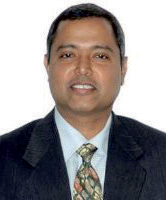
Andre Walker
Fashion Designer
Label - Andre Walker
It was always about friendship rather than the brand
Andre Walker is a New York-based renowned designer, creative director, cultural commentator, stylist and artist with a long career in creating luxury womenswear and menswear fashion, shoes, jewellery, accessories, and furs alongside his painting and mixed media practice. His key design collaborations include Comme des Garcons, Dover Street Market, Yves Salomon, Louis Vuitton, and Marc Jacobs. In an interview with Fibre2Fashion, the designer talks about American fashion and sustainability and his bond with high profile people.
Fibre2Fashion: You debuted your first collection at the age of 15 in a New York nightclub. How would you define your fashion journey?
Andre Walker:
When I was 15 and doing my own collections, I used to hang out with people in their 30s, 40s, and 50s. And, of course, people of my age too, but it was truly a multi-generational affair, which is one of the things I enjoy about fashion. My journey has been full of mistakes, experimentation, curiosity, which is how I would define it, because to say I was very strategic would be a lie. So, it was much more about passion and spontaneity, being very curious, looking at magazines, fashion shows, and being interested. I learned about art through fashion, and through art I learned about culture, and through culture I learned about life, and through life I learned about myself. I feel fortunate to have worked with some of the best designers, and I am also considered a reference too. It’s really cool when I connect the dots finally.
F2F: Where do you get your creative nutrition? What fashion do you follow?
AW:
I love old fashion magazines. I have a collection of magazines. I love print medium because you do not need electricity to look at a magazine. My imaginings, friends, life, walking around the street, going to the museums, reading, taking a chance, and obviously listening to music inspire me. There’s always inspiration. I feel like sometimes I get more inspired by words.
F2F: How would you describe your experience as artistic director at Louis Vuitton, where you worked with designers such as Kim Jones, Marc Jacobs and others?
AW:
It was a privilege to work at Louis Vuitton, but honestly it was more about my friendship with Marc that I was thinking about. I thought about the collection. I was like, oh my God, this is international. We have to do our best. We need to be progressive. We need to come up with new lines. We want to make it as fresh and as new and as alternative as we can. What I learned from Kim was about selling clothing as well, because he’s very good at selling clothes.
F2F: Can you shed some light on American fashion and what are the notable changes from earlier times till now?
AW:
American fashion is now global and that is simply because of technology. We see things from all around the world all the time, and I think that is now expressing itself in the creativity of what people see in American fashion. It is like an opening up of the culture. When you realise how many different types of immigrants are there in America, you realise that it is going to influence all the institutions as you have international designers from all over the world. For example, when you have someone from Georgia who is the art director at Balenciaga, or you have someone who was born in Africa as creative director of Dior, or someone with Gambian or Nigerian heritage raised in Chicago at LV, or someone who was born in London, like me, who has Jamaican parents. You know, we are all noticing this. There is a continual cross-pollination of information. The absorption of information and ideas is international now. And it is undeniable. It is constantly evolving because American fashion can be conceptual, artistic, and individualistic now; not only sportswear.
F2F: Can you enlighten us about your recent collaboration with Off-White and your memories with Virgil Abloh?
AW:
Yes, it is so funny because designing for Virgil Abloh involved a lot of communication through mails, photographs back and forth, as a lot of discussion was done. So, I learned a lot from him about communications over a long period of time which came to end finally in 2021, because we wanted to do this since 2017.
F2F: What will be the biggest fashion trends in the next couple of years? Any prediction?
AW:
Truth is greater than knowledge.
F2F: What does sustainability mean to you and how is your approach towards it for your collections and collaborations?
AW:
Thinking about everything we make and do and not being afraid to go the extra mile to see how truthful the effort can be.
F2F: What are you working on currently?
AW:
I have started a new project and am about to sign the contract. New York is crazy. Life is crazy, God is good, and I am extremely excited about everything that is happening.
F2F: What tips would you like to give to aspiring designers?
AW:
Choose your favourite designers, choose how you want to make clothes, choose what you want to study. You don’t have to study fashion in order to be a fashion designer and a lot of people are proving this. That’s very important. If you can learn about this industry and how supply and demand works, that will give your creative ideas an edge.
Arun Sirdeshmukh
Pradip Mehta
Rahul Mehta
Fanny Vermandel
Bill D’Arienzo
Gabi Seligsohn
Anurag Batra
Rahul Mehta
Aseem Prakash
Abhay Gupta





_8.JPG)







